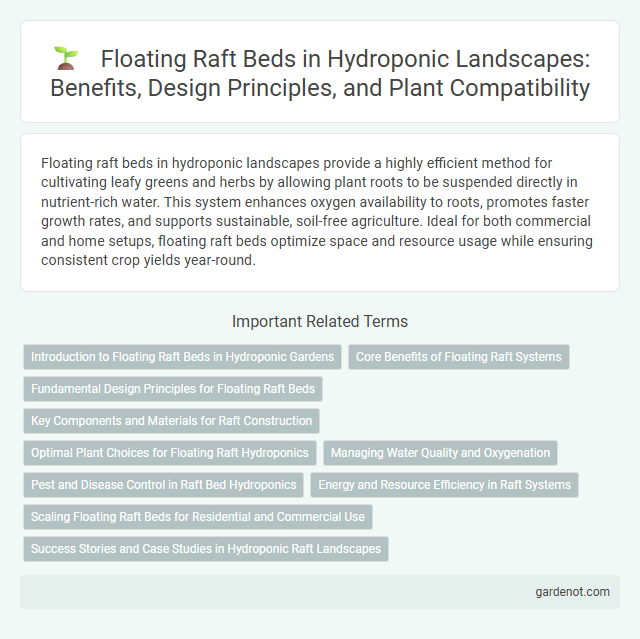Floating raft beds in hydroponic landscapes provide a highly efficient method for cultivating leafy greens and herbs by allowing plant roots to be suspended directly in nutrient-rich water. This system enhances oxygen availability to roots, promotes faster growth rates, and supports sustainable, soil-free agriculture. Ideal for both commercial and home setups, floating raft beds optimize space and resource usage while ensuring consistent crop yields year-round.
Introduction to Floating Raft Beds in Hydroponic Gardens
Floating raft beds in hydroponic gardens utilize buoyant platforms to support plants while their roots dangle directly in nutrient-rich water solutions. This soilless cultivation method enhances oxygen availability and nutrient absorption, promoting faster growth and higher yields. Commonly used for leafy greens and herbs, floating raft systems offer efficient water use and ease of maintenance in controlled environments.
Core Benefits of Floating Raft Systems
Floating raft systems in hydroponic landscapes offer superior oxygenation by suspending plant roots directly in nutrient-rich water, promoting faster growth and higher yields. This method minimizes water usage through recirculation and reduces soil-borne diseases due to the absence of soil contact. Enhanced space efficiency and simplified maintenance make floating raft beds ideal for sustainable, high-density plant production.
Fundamental Design Principles for Floating Raft Beds
Floating raft beds utilize buoyant platforms to support plant roots suspended in nutrient-rich water, optimizing oxygen and nutrient delivery for hydroponic growth. Fundamental design principles include ensuring adequate buoyancy to support plant weight, maintaining water circulation for nutrient distribution, and using durable, non-toxic materials to prevent contamination. Proper spacing and structural stability enhance root exposure and facilitate maintenance, maximizing crop yield and health in hydroponic systems.
Key Components and Materials for Raft Construction
The floating raft bed in hydroponic landscapes relies on lightweight, durable materials such as expanded polystyrene (EPS) foam or polyethylene foam for buoyancy and water resistance. Key components include a rigid frame made from corrosion-resistant aluminum or PVC to support plant growth trays and anchor points. The trays are typically constructed from UV-stabilized plastic or food-grade materials to ensure safety and longevity in aquatic environments.
Optimal Plant Choices for Floating Raft Hydroponics
Lettuce, spinach, and herbs such as basil and cilantro thrive in floating raft hydroponic systems due to their shallow root systems and rapid growth rates. Leafy greens perform optimally when nutrient solutions maintain balanced pH levels between 5.5 and 6.5, promoting efficient nutrient uptake. Selecting fast-growing, water-tolerant plants maximizes yield and ensures consistent nutrient film flow within the floating raft bed.
Managing Water Quality and Oxygenation
Floating raft beds optimize hydroponic landscapes by maintaining precise water quality parameters such as pH, nutrient concentration, and temperature to promote healthy plant growth. Effective oxygenation through aeration systems ensures sufficient dissolved oxygen levels, preventing root diseases and enhancing nutrient uptake. Continuous monitoring and adjusting of water quality and oxygenation support sustainable yields and robust crop development in hydroponic systems.
Pest and Disease Control in Raft Bed Hydroponics
Floating raft bed systems in hydroponic landscapes enhance pest and disease control by minimizing soil-borne pathogens through water-based cultivation. The continuous nutrient solution circulation inhibits fungal growth and allows for easy monitoring and management of pests such as aphids and whiteflies. Integrating biological controls and maintaining optimal water quality further reduce infestation risks in raft bed hydroponics.
Energy and Resource Efficiency in Raft Systems
Floating raft beds maximize energy and resource efficiency by minimizing water usage through recirculation systems that reduce waste. These systems utilize lightweight, buoyant materials that lower energy consumption during installation and maintenance. Integration of solar-powered pumps and sensors further optimizes resource management, ensuring sustainable crop production in hydroponic landscapes.
Scaling Floating Raft Beds for Residential and Commercial Use
Scaling floating raft beds for residential and commercial hydroponic landscapes involves optimizing buoyant platforms to support diverse crop types with efficient nutrient delivery systems. Advanced materials and modular designs enhance structural stability and adaptability, allowing seamless expansion for varying spatial requirements. Integrating automated water circulation and oxygenation technologies maximizes plant growth potential and resource efficiency in both small-scale and large-scale applications.
Success Stories and Case Studies in Hydroponic Raft Landscapes
Floating raft bed systems in hydroponic landscapes have demonstrated remarkable success in urban farming projects, boosting crop yields by up to 40% compared to traditional soil methods. Case studies from Southeast Asia highlight how these systems optimize space on water bodies, enabling large-scale cultivation of leafy greens and herbs with minimal resource input. The integration of nutrient-rich water circulation and precise environmental control in floating raft beds consistently results in healthier plants and accelerated growth cycles.
Floating raft bed Infographic

 gardenot.com
gardenot.com